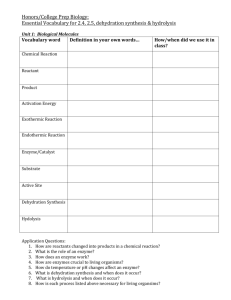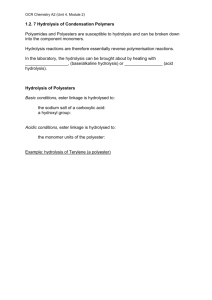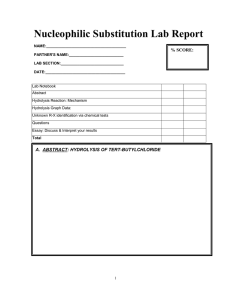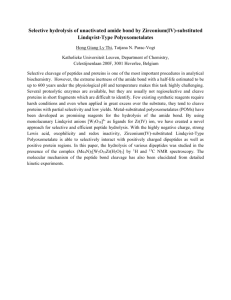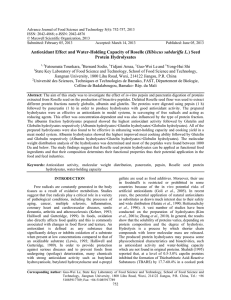Advance Journal of Food Science and Technology 11(1): 1-6, 2016 DOI:10.19026/ajfst.11.2346
advertisement
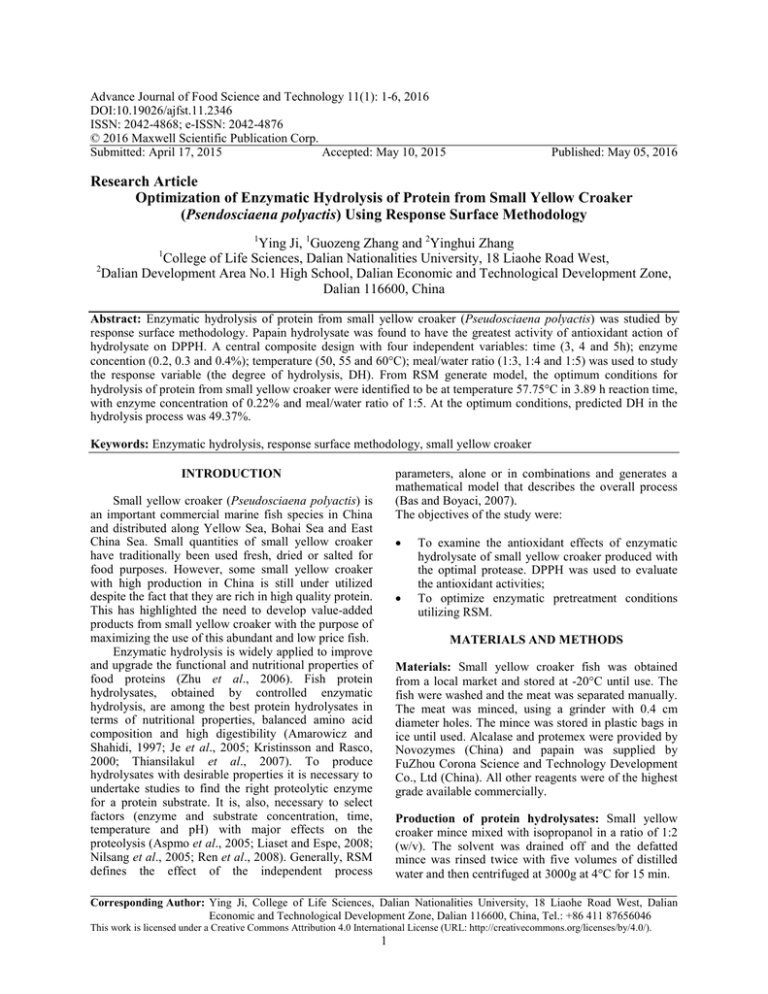
Advance Journal of Food Science and Technology 11(1): 1-6, 2016 DOI:10.19026/ajfst.11.2346 ISSN: 2042-4868; e-ISSN: 2042-4876 © 2016 Maxwell Scientific Publication Corp. Submitted: April 17, 2015 Accepted: May 10, 2015 Published: May 05, 2016 Research Article Optimization of Enzymatic Hydrolysis of Protein from Small Yellow Croaker (Psendosciaena polyactis) Using Response Surface Methodology 1 Ying Ji, 1Guozeng Zhang and 2Yinghui Zhang College of Life Sciences, Dalian Nationalities University, 18 Liaohe Road West, 2 Dalian Development Area No.1 High School, Dalian Economic and Technological Development Zone, Dalian 116600, China 1 Abstract: Enzymatic hydrolysis of protein from small yellow croaker (Pseudosciaena polyactis) was studied by response surface methodology. Papain hydrolysate was found to have the greatest activity of antioxidant action of hydrolysate on DPPH. A central composite design with four independent variables: time (3, 4 and 5h); enzyme concention (0.2, 0.3 and 0.4%); temperature (50, 55 and 60°C); meal/water ratio (1:3, 1:4 and 1:5) was used to study the response variable (the degree of hydrolysis, DH). From RSM generate model, the optimum conditions for hydrolysis of protein from small yellow croaker were identified to be at temperature 57.75°C in 3.89 h reaction time, with enzyme concentration of 0.22% and meal/water ratio of 1:5. At the optimum conditions, predicted DH in the hydrolysis process was 49.37%. Keywords: Enzymatic hydrolysis, response surface methodology, small yellow croaker parameters, alone or in combinations and generates a mathematical model that describes the overall process (Bas and Boyaci, 2007). The objectives of the study were: INTRODUCTION Small yellow croaker (Pseudosciaena polyactis) is an important commercial marine fish species in China and distributed along Yellow Sea, Bohai Sea and East China Sea. Small quantities of small yellow croaker have traditionally been used fresh, dried or salted for food purposes. However, some small yellow croaker with high production in China is still under utilized despite the fact that they are rich in high quality protein. This has highlighted the need to develop value-added products from small yellow croaker with the purpose of maximizing the use of this abundant and low price fish. Enzymatic hydrolysis is widely applied to improve and upgrade the functional and nutritional properties of food proteins (Zhu et al., 2006). Fish protein hydrolysates, obtained by controlled enzymatic hydrolysis, are among the best protein hydrolysates in terms of nutritional properties, balanced amino acid composition and high digestibility (Amarowicz and Shahidi, 1997; Je et al., 2005; Kristinsson and Rasco, 2000; Thiansilakul et al., 2007). To produce hydrolysates with desirable properties it is necessary to undertake studies to find the right proteolytic enzyme for a protein substrate. It is, also, necessary to select factors (enzyme and substrate concentration, time, temperature and pH) with major effects on the proteolysis (Aspmo et al., 2005; Liaset and Espe, 2008; Nilsang et al., 2005; Ren et al., 2008). Generally, RSM defines the effect of the independent process • • To examine the antioxidant effects of enzymatic hydrolysate of small yellow croaker produced with the optimal protease. DPPH was used to evaluate the antioxidant activities; To optimize enzymatic pretreatment conditions utilizing RSM. MATERIALS AND METHODS Materials: Small yellow croaker fish was obtained from a local market and stored at -20°C until use. The fish were washed and the meat was separated manually. The meat was minced, using a grinder with 0.4 cm diameter holes. The mince was stored in plastic bags in ice until used. Alcalase and protemex were provided by Novozymes (China) and papain was supplied by FuZhou Corona Science and Technology Development Co., Ltd (China). All other reagents were of the highest grade available commercially. Production of protein hydrolysates: Small yellow croaker mince mixed with isopropanol in a ratio of 1:2 (w/v). The solvent was drained off and the defatted mince was rinsed twice with five volumes of distilled water and then centrifuged at 3000g at 4°C for 15 min. Corresponding Author: Ying Ji, College of Life Sciences, Dalian Nationalities University, 18 Liaohe Road West, Dalian Economic and Technological Development Zone, Dalian 116600, China, Tel.: +86 411 87656046 This work is licensed under a Creative Commons Attribution 4.0 International License (URL: http://creativecommons.org/licenses/by/4.0/). 1 Adv. J. Food Sci. Technol., 11(1): 1-6, 2016 Table 1: The degree of hydrolysis and the IC50 value for DPPH activity of hydrolysates using various proteases Optimal hydrolysis DH IC50 conditions (%) (mg/mL) Proteases Alcalase 29.31 1.784 pH 8.0, 55℃ Protemex 28.60 1.722 pH 7.0, 55℃ Papain 30.47 1.561 pH 7.0, 50℃ individual points, was employed to study the effects of enzymatic treatments on hydrolysis of protein from small yellow croaker. The independent variables and their levels were selected such as time (3-5h), enzyme concention (0.2%-0.4%), temperature (50-60°C) and meal/water ratio (1:3-1:5). The independent variables and their levels are presented in Table 2. Each experiment had three replications and the degree of hydrolysis (DH) was taken as the response, Y. Table 2: Independent variables and their levels used for the central composite rotatable design (CCRD) and optimization of enzymatic pretreatment conditions Levels ---------------------------------Independent variable Symbol -1 0 1 Time (h) x1 3 4 5 Enzyme concention (%) x2 0.2 0.3 0.4 x3 50 55 60 Temperature (℃) Meal/water ratio (w/v) x4 1:3 1:4 1:5 The Response Surface Statistical analysis: Methodology (RSM) procedure of statistical analysis system (Design-Expert 7.0) was used to fit the experimental data to the second order polynomial equation to obtain coefficients of the Eq. (3): The resulting isopropanol defatted mince was mixed with distilled water at meal/water ratio of 1:3, 1:4 and 1:5(w/v), respectively and blended to obtain a homogeneous slurry. The hydrolysis reaction was started by the addition of the proteases at different levels of 0.2, 0.3 and 0.4% (w/w). The slurries containing enzymes were incubated in a water bath at temperature (50-60°C) for a selected period of time (35h). The enzymatic pretreatment variables are presented in Table 1. The mixture was then centrifuged at 2000 rpm at 4°C for 10 min and the supernatant was collected. Y = β 0 + ∑ β i xi + ∑ β ii xi2 + ∑ β ij xi x j where, Y is the response variable, xi and xj are the coded independent variables and β0, βi, βii and βij are the regression coefficients of variables for intercept, linear, quadratic and interaction regression terms, respectively. The significant terms in the model were found by analysis of variance (ANOVA) for each response. The significance of each coefficient in the polynomial was tested using the Student t-test and the adequacy of model was checked accounting for R2. The regression coefficients were used for statistical calculations to generate response surfaces and contour plots. Determination of the degree of hydrolysis: Degree of hydrolysis was estimated as per the methodology described by Hoyle and Merritt (1994). Briefly, degree of hydrolysis was computed as: 10% TCA soluble N 2 in the sample % DH = × 100 Total N 2 in the sample RESULTS AND DISCUSSION Effect of commercial food grade proteases on the degree of hydrolysis: Three commercial food grade proteases were used to hydrolyze the small yellow croaker and each hydrolysis experiment was carried out with a given optimal condition provided by manufacturers (Table 1). Since DH is defined as the percentage of peptide bonds cleaved by protease (Alder-Nissen, 1979), the hydrolysate with high DH is believed to contain more low-molecular peptides than the hydrolysate with low DH. Table 1 shows the highest DH value (30.47%) was observed from papain when the protein was hydrolyzed for 4 h. The order of DH for the three hydrolysates was papain hydrolysate> alcalase hydrolysate> protemex hydrolysate. Moreover, the mechanism of antioxidant action of hydrolysate on DPPH radical scavenging was thought to be due to their hydrogen-donating ability (Binsan et al., 2008), so DPPH was used as another measure for estimating the effect of the tested proteases. The results indicate that the minimum IC50 value for the DPPH activity was observed from the hydrolysates prepared with papain. The IC50 value refers to the concentration of hydrolysate that causes a decrease in the hydrogendonating ability by 50% and the lower IC50 value means the higher hydrogen-donating ability. The comparison (1) DPPH radical-scavenging activity: DPPH radicalscavenging activity was determined as described by Wu et al. (2003) with a slight modification. To diluted sample (1.5 mL), 1.5 mL of 0.1 mM DPPH in 95% ethanol were added. The mixture was then mixed vigorously and allowed to stand at room temperature in the dark for 30 min. The absorbance of the resultant solution was read at 517 nm using a UV-2100 spectrophotometer (UNICO Instruments Co., Ltd, Shanghai, China). The blank was prepared in the same manner, except that distilled water was used instead of sample. The scavenging effect was calculated as follows: Radical - scavenging activity (%) = [(B - A)/B] × 100 (3) (2) where A is A 517 of sample and B is A 517 of the blank Experimental design: A statistical tool utilizing three levels, four variables and Central Composite Rotatable Design (CCRD) (Cochran and Cox, 1992), with 29 2 Adv. J. Food Sci. Technol., 11(1): 1-6, 2016 Table 5: Analysis of variance (ANOVA) of the regression parameters for the response surface model Degree of Regression freedom SS R2 F-value p-value Linear 4 236.79 0.6042 9.16 0.0001 Quadratic 4 94.80 0.8844 7.32 0.0021 Cross 8 24.13 0.9459 0.85 0.5934 product Total 29 355.72 0.8844 7.65 model 0.0003 SS: Sum of squares Table 3: Central Composite Rotatable Design (CCRD) and response Independent variables ------------------------------------------Response x1 x2 x3 x4 DH (%) Experiment 1 1 1 0 0 39.69 2 0 0 1 1 45.89 3 0 0 0 0 45.64 4 0 0 1 -1 38.79 5 0 -1 0 1 48.83 6 0 1 1 0 40.1 7 0 0 -1 1 40.44 8 1 0 -1 0 39.92 9 0 -1 -1 0 40.54 10 0 0 0 0 45.64 11 1 0 0 -1 43.89 12 0 1 -1 0 36.38 13 0 0 0 0 45.64 14 -1 -1 0 0 43.47 15 -1 0 0 -1 42.64 16 -1 0 1 0 43.85 17 1 0 1 0 40.35 18 -1 0 0 1 44.85 19 1 -1 0 0 44.19 20 0 0 0 0 45.64 21 -1 0 -1 0 37.77 22 0 0 0 0 45.64 23 0 -1 0 -1 39.75 24 0 0 -1 -1 36.39 25 0 -1 1 0 48.02 26 -1 1 0 0 37.54 27 0 1 0 1 43.73 28 1 0 0 1 47.37 29 0 1 0 -1 35.66 Table 4: Significance of regression coefficients o the order polynomial model for response Regression Mean Variables coefficient square F-value β1 0.44 2.33 0.72 β2 -2.64 83.74 25.87 2.13 54.44 16.82 β3 -1.30 10.92 3.37 β4 -2.25 32.87 10.16 β11 -3.43 76.48 23.63 β22 -0.96 5.98 1.85 β33 β44 2.83 96.28 29.74 0.36 0.51 0.16 β12 -1.41 7.98 2.47 β13 0.32 0.40 0.12 β14 β23 -0.94 3.53 1.09 -0.25 0.26 0.08 β24 0.76 2.33 0.72 β34 meal/water ratio on the DH value by using RSM. Table 3 shows the experimental conditions and corresponding responses according to the experimental design. After the RSM procedure, the regression equation was given as follows (in coded units): y = 45.64 + 0.44 x1 − 2.64 x 2 + 2.13x3 − 1.3 x 4 + 0.36 x1 x 2 − 1.41x1 x3 + 0.32 x1 x 4 − 0.94 x 2 x3 − 0.25 x 2 x 4 + 0.76 x3 x 4 − 2.25 x12 − 3.43x 22 − 0.96 x32 + 2.83x 42 (4) The significance of each coefficient in Eq. (4) was determined using the Student t test and P value as shown in Table 4. It was evident that the linear coefficients except for β1 were significant (p<0.001), while the quadratic coeffcients except β11 and β44 and all the cross product coefficients were insignificant (p>0.05). These results suggest that β2, β3, β4, β22, β33 were significant model terms in this study. The results of Analysis of Variance (ANOVA) for the response surface model are shown in Table 5. The model has shown a good fit with the experimental data, since the coefficient of determination R2 had a value of 0.8844. This means that the fitted model could explain 88.44% of the total variability within the range of values studied. The probability P value of the regression model significance was less than 0.001. Therefore, the model adequately represented the real relationship among the parameters chosen. Figure 1 shows that the polynomial regression model was in good agreement with the experimental results. In this figure, each of the observed values is compared to the predicted value calculated from the model. All these results imply a satisfactory mathematical description of the hydrolysis process by the fitted model Eq. (4). fitted second p-value 0.4103 0.0002 0.0011 < 0.0001 0.0876 0.0066 0.0003 0.1957 0.6971 0.1387 0.7294 0.3138 0.7831 0.4109 of IC50 values revealed that the order of the antioxidant activity was papain hydrolysate> protemex hydrolysate> alcalase hydrolysate. Among the three hydrolysates, papain hydrolysate exerted the highest inhibition, so papain was thought to be superior and hence chosen for use in the small yellow croaker hydrolysis. This is consistent with the results of Ren et al. (2008) and You et al. (2009), who found that hydrolysates prepared by papain exhibited the strongest antioxidant activity. Validation of the model: The three-dimensional response surface graphs were drawn to illustrate the main and interactive effects of the independent variables on the Degree of Hydrolysis (DH) as shown in Fig. 2 to 4. The time of hydrolysis had no significant effect on DH and was maintained at 4 h (coded zero level). The response surface and contour plots of the effects of enzyme concentration and temperature on hydrolysis of fish at time 4 h and meal/water ratio of 1:4 are presented in Fig. 2. The results indicated that enzyme concentration displayed a quadratic effect on the response. DH increased up to about enzyme concentration 0.32%, followed by a decline with its further increase, while the temperature displayed a Model fitting: Papain was found to be the most suitable enzyme for producing peptides with high antioxidant activity, so we investigated the effects of time, enzyme concentration, temperature and the 3 Adv. J. Food Sci. Technol., 11(1): 1-6, 2016 Fig. 1: Relationship between the observed and predicted values of the degree of hydrolysis Fig. 2: Response surface plots of DH as a function of enzyme concentration and temperature during hydrolysis of protein from small yellow croaker at time 4.0 h and meal/water ratio of 1:5 linear effect on the response and the DH decreased with an increase of temperature. The effects of enzyme concentration and meal/water ratio during hydrolysis of fish at time 4 h and temperature of 55°C are shown in Fig. 3. The results indicated that meal/water ratio and enzyme concentration all demonstrated a quadratic effect on the response and the amount of enzyme displayed a maximum DH at 0.25% enzyme concentration. The effects of temperature and meal/water ratio during hydrolysis of fish at time 4.0 and enzyme concentration of 0.3% are shown in Fig. 4. Temperature and meal/water ratio exerted a quadratic effect on the response, yielding maximum DH at temperature of 56°C and meal/water ratio of 1:4.2. 4 Adv. J. Food Sci. Technol., 11(1): 1-6, 2016 Fig. 3: Response surface plots of DH as a function of enzyme concentration and meal/water ratio during hydrolysis of protein from small yellow croaker at time 4.0 and temperature of 55℃ Fig. 4: Response surface plots of DH as a function of temperature and meal/water ratio during hydrolysis of protein from small yellow croaker at time 4.0 and enzyme concentration of 0.3% Table 6: Optimum conditions of hydrolysis, predicted and experimental DH for RSM Optimum condition -------------------------------------------------------------------------------------------------------------Time (h) enzyme concentration(%) Temperature (℃) meal/water ratio (v/w) 3.89 0.22 57.75 1:5 Optimum conditions and model verification: From the model, optimized conditions were obtained as given in Table 6. The maximum DH of hydrolysate was when time was 3.89 h, enzyme concentration was 0.22% and DH (%) ---------------------------------------------------------Predicted value Experimental value 49.37 49.50 temperature was 57.75°C while meal/water ratio was 1:5. Under the optimum conditions a maximum response of DH (49.37%) was predicted. To confirm the validity of the model, three assays were performed 5 Adv. J. Food Sci. Technol., 11(1): 1-6, 2016 under the optimal conditions given above. As shown in Table 6, the DH value for these conditions was 49.50%. The results indicated that the experimental value (49.50%) was found to be in agreement with the predicted one (49.37%) and the above results also confirmed that the model was powerful and suitable for the estimation of experimental values. Cochran, W.G. and G.M. Cox, 1992. Some Methods for the Study of Response Surfaces. In: Experimental Designs. Wiley, New York, pp: 335-375. Hoyle, N.T. and J.H. Merritt, 1994. Quality of fish protein hydrolysate from Herring (Clupea harengus). J. Food Sci., 59: 76-129. Je, J.Y., P.J. Park and S.K. Kim, 2005. Antioxidant activity of a peptide isolated from Alaska pollack (Theragra chalcogramma) frame protein hydrolysate. Food Res. Int., 38: 45-50. Kristinsson, H.G. and B.A. Rasco, 2000. Fish protein hydrolysates: Production, biochemical and functional properties. CRC Cr. Rev. Food Sci., 40: 43-81. Liaset, B. and M. Espe, 2008. Nutritional composition of soluble and insoluble fractions obtained by enzymatic hydrolysis of fish-raw materials. Process Biochem., 43: 42-48. Nilsang, S., S. Lertsiri, M. Suphantharika and A. Assavanig, 2005. Optimization of enzymatic hydrolysis of fish soluble concentrate by commercial proteases. J. Food Eng., 70: 571-578. Ren, J.Y., M.M. Zhao, J. Shi, J.S. Wang, Y.M. Jiang, C. Cui, Y. Kakuda and S.J. Xue, 2008. Optimization of antioxidant peptide production from grass carp sarcoplasmic protein using response surface methodology. Food Sci. Technol., 41: 1624-1632. Thiansilakul, Y., S. Benjakul and F. Shahidi, 2007. Compositions, functional properties and antioxidative activity of protein hydrolysates prepared from round scad (Decapterus maruadsi). Food Chem., 103: 1385-1394. Wu, H.C., H.M. Chen and C.Y. Shiau, 2003. Free amino acids and peptides as related to antioxidant properties in protein hydrolysates of mackerel (Scomber austriasicus). Food Res. Int., 36: 949-957. You, L., M. Zhao, C. Cui, H. Zhao and B. Yang, 2009. Effect of degree of hydrolysis on the antioxidant activity of loach (Misgurnus anguillicaudatus) protein hydrolysates. Innov. Food Sci. Emerg., 10: 235-240. Zhu, K., H. Zhou and H. Qian, 2006. Antioxidant and free radical-scavenging activities of wheat germ protein hydrolysates (WGPH) prepared with alcalase. Process Biochem., 41: 1296-1302. CONCLUSION Small yellow croaker protein was effectively hydrolyzed by papain to obtain peptides with a strong antioxidant activity. We investigated the effects of time, enzyme concention, temperature and the meal/water ratio on the DH value by response surface methodology. The optimal hydrolysis conditions were estimated as time 3.89h, temperature 57.75°C, enzyme concentration of 0.22% and meal/water ratio of 1:5. Accordingly, the highest DH value was estimated as 49.37%, which was subsequently confirmed by experiments. For further study, these results need focus on the peptides fraction and the relationship of structure and function of bioactive peptides from small yellow croaker. ACKNOWLEDGMENT This research was supported by the Key Program of National Natural Science Foundation of China (No. 31301447) and the Fundamental Research Funds for the Central Universities (DC201502020204). REFERENCES Alder-Nissen, J., 1979. Determination of the degree of hydrolysis of food protein hydrolysates by trinitrobenzene sulphonic acid. J. Agr. Food Chem., 27: 1256-1262. Amarowicz, R. and F. Shahidi, 1997. Antioxidant activity of peptide fractions of capelin protein hydrolysates. Food Chem., 58: 355-359. Aspmo, S.I., S.J. Horn and V.G.H. Eijsink, 2005. Enzymatic hydrolysis of Atlantic cod (Gadus morhua L.) viscera. Process Biochem., 40: 1957-1966. Bas, D. and I.H. Boyaci, 2007. Modeling and optimization I: Usability of response surface methodology. J. Food Eng., 78: 836-845. Binsan, W., S. Benjakul, W. Visessanguan, S. Roytrakul, M. Tanaka and H. Kishimura, 2008. Antioxidative activity of Mungoong, an extract paste, from the cephalothorax of white shrimp (Litopenaeus vannamei). Food Chem., 106: 185-193. 6
